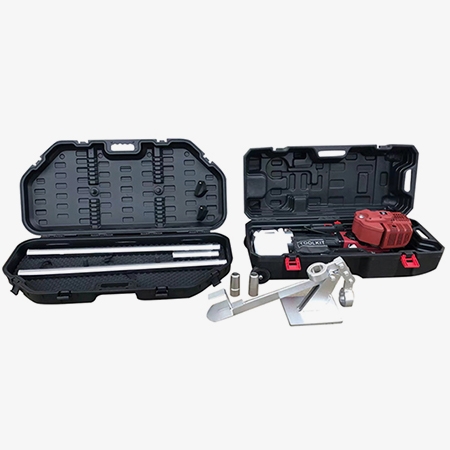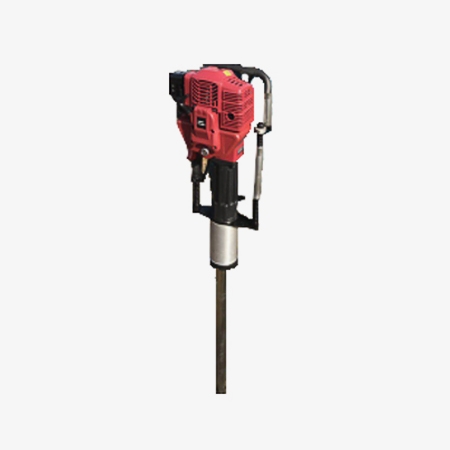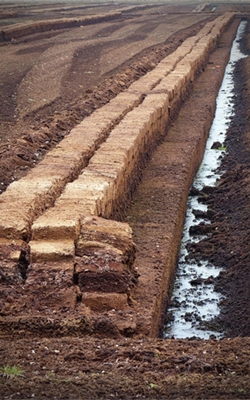Compared with conventional large drilling rigs, soil drilling machines for sampling are more convenient to carry and operate, and non-professionals can easily complete the operation of the equipment. In some project sites with low depth requirements (within 10 meters), relatively complex terrain, and difficult access for large equipment, using this equipment is the best choice.

Scalability and multifunctionality
- The soil drilling machine for sampling can be equipped with different sampling accessories (such as soil gas samplers, water sample collectors, etc).
- Some drilling rigs also support the installation of core sampling devices and in-situ testing equipment (such as standard penetration testing tools).
- The soil drilling machine for sampling can be applied to various types of soil (such as clay, sandy soil, loam, gravel layer, etc).

Fast footage, sample remains in its original state, without disturbance
- Mechanical power-driven drilling of the soil sampler is fast, efficient, and can continuously sample, improving work efficiency.
- The soil drilling machine for sampling adopts a modular design, is easy to maintain and replace components.
- Hand-pulled start, stop trigger button, spring-isolated shock-resistant handle, and a more reasonable ergonomic design of the puller, which can be manually pressed or stepped on.
Applications
A soil sampler is widely used in agriculture, environmental monitoring, and geotechnical analysis. It is ideal for sampling in wetlands, tidal flats, and can collect soils such as marsh, peat, and sediment. The sampler helps assess soil health, nutrient levels, and pH in agriculture, detects contamination in environmental studies, and evaluates soil stability in construction projects. It also supports research, land reclamation, and conservation by providing insights into soil quality and promoting sustainable land management.

River

Peat Soil

Lake

Tidal Flat
| Model | SISCO-SS-JCTQZ |
| Vibration Frequency | 1300 times/minute |
| Power | 1.6 horsepower (7000 rpm) |
| Sampling Length | 1-10 meters (optional) |
| Engine Type | Single-cylinder two-stroke engine |
| Fuel Consumption | Not exceeding 0.6L/h |
| Weight | 20.2 kg (main unit) |
| Sample Tube Specifications | Inner and outer diameters not less than 35mm/40mm; Length not less than 1.00 meters per piece |
| Pulling Device | Quick pulling, speed not less than 3.00 meters per minute |
Q1: What is a soil drilling machine used for in sampling?
A1: A soil drilling machine is used to bore into the ground to collect soil samples from different depths. It helps in geotechnical investigations, environmental assessments, agricultural soil testing, and construction site evaluations.
Q2: What types of soil sampling can be done with a drilling machine?
A2: It can be used for:
- Disturbed sampling (e.g., auger sampling).
- Undisturbed sampling (e.g., Shelby tube or core sampling).
- Split-spoon sampling (for Standard Penetration Tests - SPT).
- Cone penetration testing (CPT) is equipped.
Q3: How accurate are samples obtained with drilling machines?
A3: Accuracy depends on the sampling method. Undisturbed core samples yield more accurate results for lab testing, while disturbed samples are typically used for general classification.
Tips: How to use and operate the soil drilling machine for sampling?
- Choose the appropriate drill bit type: Select the appropriate drill bit based on the soil type (spiral drill bit, core tube drill bit, impact drill bit, etc.). For example, sandy soil is suitable for spiral drilling, while cohesive soil can use stronger core pipe drill bits.
- Pre-check the condition of the equipment: check whether the power system, hydraulic system, and drill pipe connection of the drilling rig are secure, and ensure that the equipment is in good condition before operation.
- The drilling speed should be moderate: too fast may cause the drill rod to bend or sampling to fail, while too slow may reduce efficiency. The footage speed and pressure need to be adjusted according to the soil quality. Maintain the verticality of the borehole:
- Try to maintain vertical drilling to avoid deviation affecting sample representativeness and subsequent analysis. Timely cleaning of the drill bit: Especially in sticky or moist soil, it is easy to block the drill bit, and it is necessary to regularly remove attachments.
Thank you for buying industrial test and measurement equipment on SISCO.com, all products sold by SISCO and the partner cover a 12 months warranty, effective from the date of receiving the products.
What is covered?
SISCO is responsible for providing free spare parts, and free technical support to assist the customer to repair the defective products until the problem is solved.
What is not covered?
- Product purchased from anyone other than a SISCO store or a SISCO authorized reseller.
- Expendable parts.
- Routine cleaning or normal cosmetic and mechanical wear.
- Damage from misuse, abuse or neglect.
- Damage from use of parts other than SISCO approved.
- Damage from use outside the product’s usage or storage parameters.
- Damage from use of parts not sold by SISCO.
- Damage from modification or incorporation into other products.
- Damage from repair or replacement of warranted parts by a service provider other than a SISCO authorized service provider.
- Damage caused by the application environment not meeting the product usage requirements and the failure to perform preventive maintenance.

